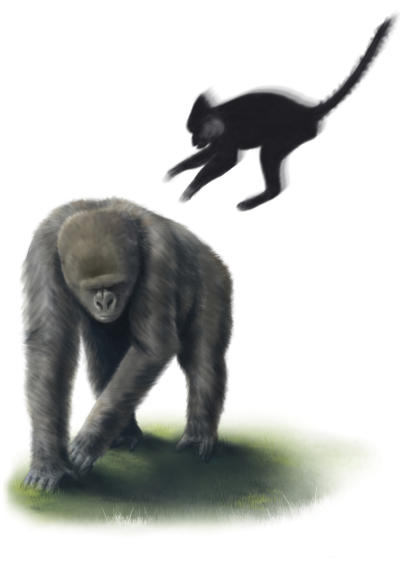
It was Spring break 2004. I was 9 years of age and during the holidays I made two trips with my grandparents. As always, we went to Blijdorp Zoo in Rotterdam and a few days later for the first time to Museum Naturalis in Leiden. I was amazed; all those animals, landscapes and showcases made an incredible impression on me. I talked about it every day for at least another week.
Monday, February 24, 2020. Once again, I found myself at Naturalis in Leiden, but this time not as a visitor, but as part of my graduation project for my master in Scientific Illustration. I was allowed to take a look behind the scenes, in this case at the skeletons of black crested mangabeys. There I was, standing in the Naturalis archive with two archive boxes open in front of me. To my great surprise, both skeletons (dated 1903 and 1904) were originally from… Rotterdam Zoo.
At that moment I was sure: the circle is complete! This graduation project unites things that have always been important to me: observing, nature, animals, research, design and drawing.
However, a graduation project in Scientific Illustration requires much more than a fascination and beautiful illustrations. It is a quest. A quest for a suitable subject and setting. A quest into the need for illustrations and the goals and target groups they are intended for. And of course, the quest for the illustration style most suitable for its purpose.If possible, a specific illustrative challenge in this project would be desirable as well. And finally: the search for the professional scientific illustrator in me.
I would like to take you on that quest and share the things I have done during my graduation project, the choices I have made and the justification for them.
And though a quest is also about meeting people and sharing experiences, a graduation project sometimes can be an individual and even lonesome experience, especially under the unknown and uncertain circumstances in the spring months of 2020, caused by the Covid-19 pandemic. Every participant in my graduation project had to deal with this, adjust working routines en improvise to keep progress. I consider myself very lucky with the support of all the people I have met on my quest. In the first place I would like to thank the teaching staff of the Master of Scientific Illustration in general and Jacques Spee in particular, for their remarks, suggestions and feedback on my project and this report. At GaiaZOO a special word of thanks goes out to Emile Prins and Tjerk Termeulen for giving me access to the zoo and all the information I needed on western lowland gorillas and black crested mangabeys. And for the missing links and references of the mangabeys anatomy my acknowledgements go out to Pepijn Kamminga at Naturalis and Emmanuel Gilissen at the Afrika Museum. And finally, I would like to thank fellow students Tiffany Fung and Margot Ceelen for keeping up the spirit at a distance, a lot of fun and their professional input.





















The research project at GaiaZOO investigates the communication between two different species of primates, the western lowland gorilla (gorilla gorilla gorilla) and the black crested mangabey (lophocebus aterrimus), which are kept in one enclosure in the zoo. This is a clinical setting; the two species are brought into contact with each other, but would never meet in the wild. The illustrations I will make are therefore exclusive to that specific setting.
The research at GaiaZOO concerns the interaction and communication within (intraspecies) and between both species (interspecies). My illustrations for GaiaZOO should therefore only relate to aspects of interaction and communication or functionally support it.